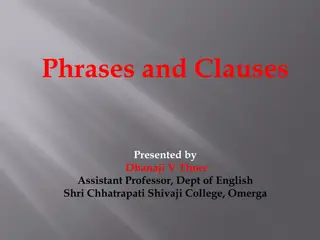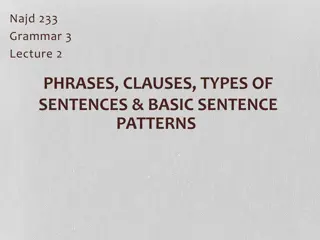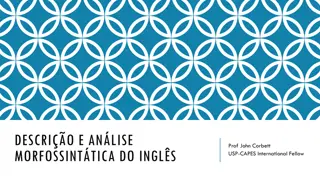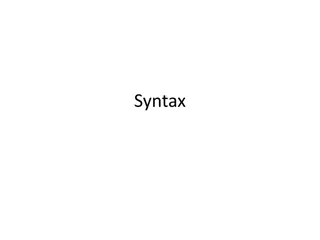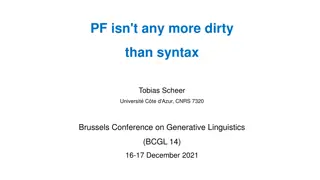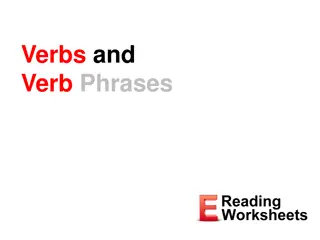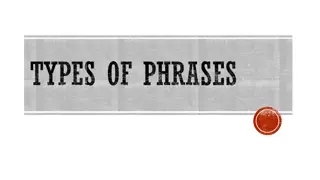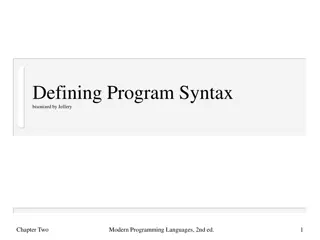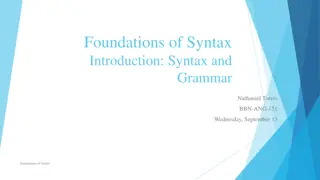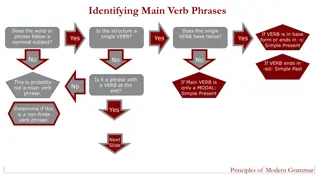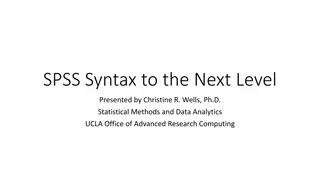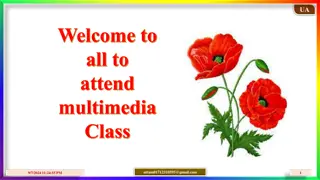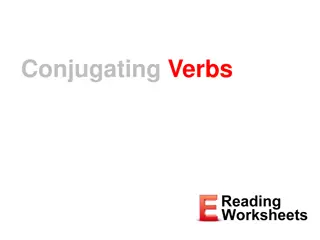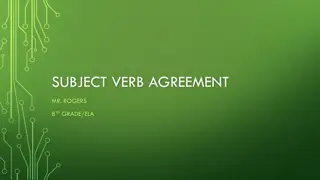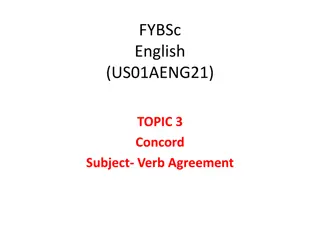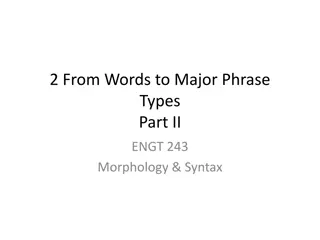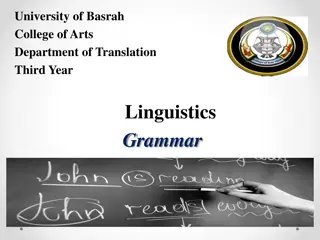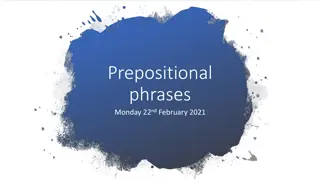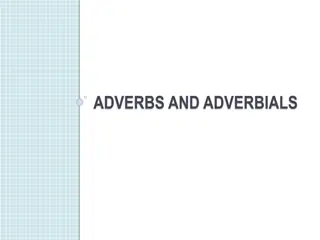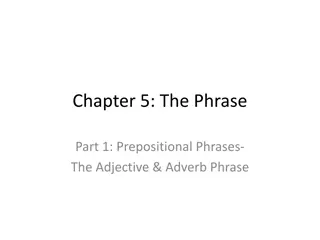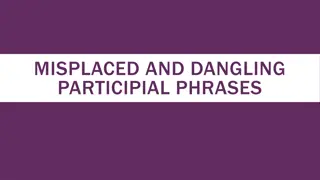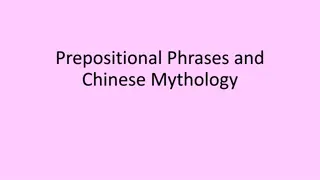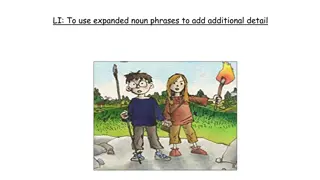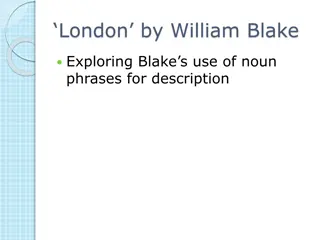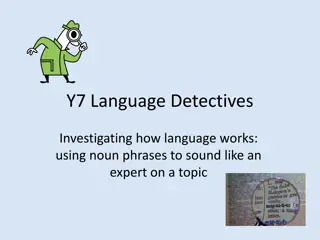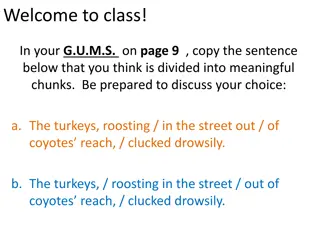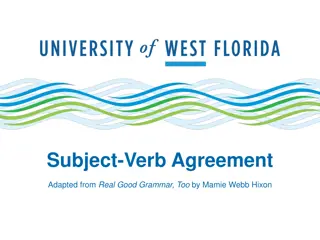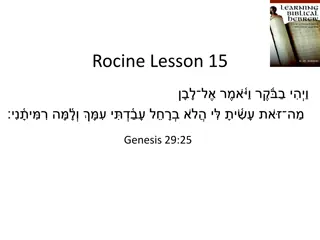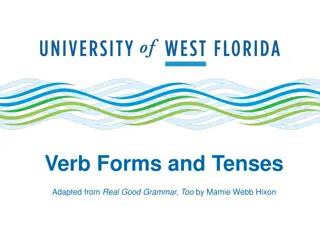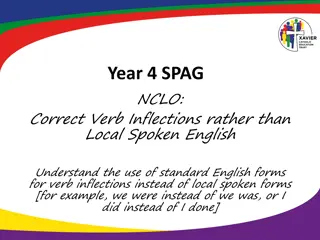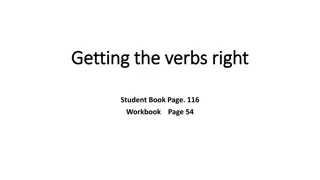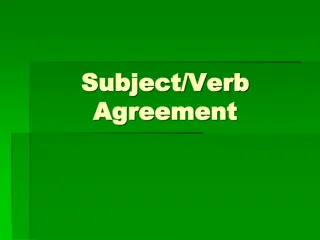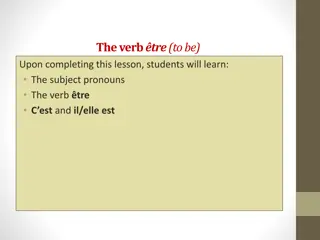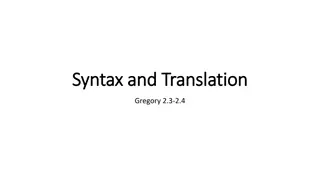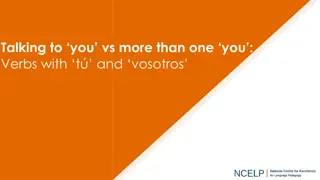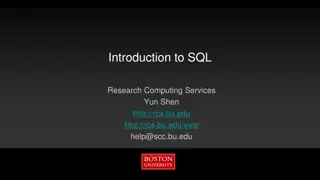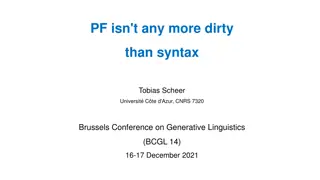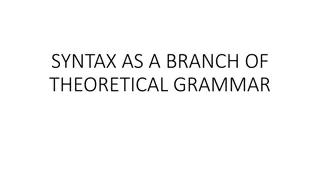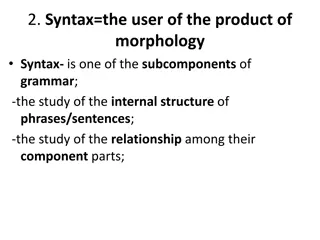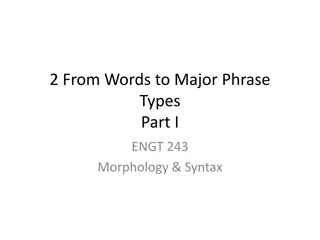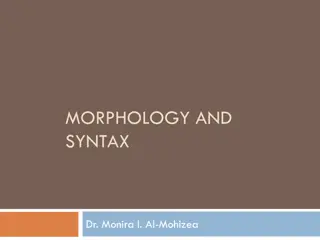Understanding Verb Phrases in Syntax
In this study, we delve into the intricacies of verb phrases within the realm of syntax. Starting with the basic structure of the Verb Phrase (VP), we explore intransitive and transitive verbs, their expansion with adverbs, prepositional phrases, and direct objects. By analyzing examples and discussing various elements that can enhance the VP, we gain a comprehensive understanding of how these components function within sentence formation.
Download Presentation

Please find below an Image/Link to download the presentation.
The content on the website is provided AS IS for your information and personal use only. It may not be sold, licensed, or shared on other websites without obtaining consent from the author. Download presentation by click this link. If you encounter any issues during the download, it is possible that the publisher has removed the file from their server.
E N D
Presentation Transcript
Foundations of Syntax: Phrases II Nathaniel Torres BBN-ANG-151 Wednesday, October 25
Review Last time we discussed the Noun Phrase, which we have seen is quite robust, and can vary considerably cross-linguistically. We have seen that it is possible to augment the noun phrase with various other phrases, such as adjective phrases and prepositional phrases. We can now expand our overview of phrases by discussing these other phrasal categories so that we have a better idea of phrase structure.
The Verb Phrase (VP) Like the noun phrase, the verb phrase requires a basic element to project the phrase. This is the verb head. The verb head is minimally needed in order to create a predicate that can be combined with an NP subject in order to create a full clause (sentence). With this in mind, we can take a look at the various kinds of VP and their structures that you will encounter.
The VP As we said on the previous slide, the verb phrase (cross-linguistically) requires at minimum a verb. Let s consider verbs like run, fall, or dance. This allows us to form sentence in English John runs. The rain falls. Mary dances. These are all full sentences in English which are composed of two parts: the subject NP and the VP predicate. The VP in predicate is, in these cases, simple in that it is just the verb. Verbs like the ones above are called intransitive.
The VP (cont.) Is this the full extent to which intransitive VPs can be expanded? We can modify intransitive VPs with other elements. Consider: Mary dances poorly. In this sentence we can see that we can add an adverb into the intransitive verbal domain in order to give us information about how the action is done. Is this all we can add to the intransitive verbal domain? Consider now: Mary danced poorly at the fair in August. This sentence showcases clearly that in addition to adverbs, we can also modify our intransitive verb with prepositional phrases and temporal adverbials in order to further describe the event.
The VP (cont.) The VP may of course be expanded to include a number of other elements. We can look at exmaples like we have seen before: The dog bit the man. John kicked the ball. John hit the baseball. Verbs like bite, kick and hit are called transitive verbs because they take direct objects. So, we can see in these examples that the VP can be expanded to include nominal elements in their domains.
The VP (cont.) The transitive verb can also be modified in a manner just like that of the intransitive verb. We can expand the VP to include other elements like adverbs and prepositional verbs. Mary hit the volleyball hard at the state championship. John very often visits his grandparents in Tallahassee for Thanksgiving. Placement of these elements is contingent on the phrase in question because word order does matter. You will notice that placement of adverbs is typically fine before the verb in English, but it is not ok to place prepositional phrases before them: *John for Thanksgiving visits his grandparents in Tallahassee very often.
The Transitive VP In addition to the fact that one cannot play around with the order of elements in the English VP, there is another stark word order rule. Nothing can come between the verb and its direct object in English. Consider: John usually visits his grandparents for Thanksgiving in Tallahassee. But now consider: *John usually visits for Thanksgiving his grandparents in Tallahassee. *John visits usually his grandparents for Thanksgiving in Tallahassee. So, placement of some other phrase in between the verb and its object results in a stark ungrammaticality in English.
The Transitive VP (cont.) One further observation in the transitive VP is that the elements modifying (or describing) the verb can come in any order. Consider the following sentences: Mary eats goulash very frequently at restaurants in Hungary. Mary very frequently eats goulash at restaurants in Hungary. Mary eats goulash in Hungary at restaurants very frequently. There are a number of possible permutations that increase contingent on the number of modifying phrases one can find in the VP.
The VP (cont.) There is one other kind of VP that we can discuss. These are VPs composed of ditransitive verbs like give, send, tell, write, etc. Consider: John gave Mary flowers for Valentine s Day. John sent Kate a love letter for Valentine s Day. John told Erica a love story for Valentine s Day. John wrote Kimiko a poem for Valentine s Day. We notice a pattern in all of these VPs in that unlike their transitive counterparts, these verbs take not one but two objects: the indirect (recipient) object and the direct (patient) object.
The Ditransitive VP The ditransitive VP in English is interesting because it shows us that it is possible for verbs to take two objects. Can they take more than that? *John wrote Jane a letter a dog for Valentine s Day. We can see that it is impossible to add more noun phrases to the VP in English which tells us that the English VP can take between 0-2 objects, contingent on the transitivity of the verbal predicate. Otherwise, the ditransitive verbal predicate looks like the transitive and intransitive counterparts in that it too can take any number of modifying phrases and place them in any order. John wrote Jane a letter for Valentine s Day with a blue pen under a tree by the river near the school.
The Cross-Linguistic VP English and many other languages are required to express their subjects in addition to their predicates. This is not a property that is shared across languages as expression of the subject is not a necessity for languages that have a more robust morphological inventory. Specifically, so-called pro-drop languages allow for verbs to seemingly appear on their own.
Subjectless VPs Many Indo-European, Uralic, and Turkic languages drop their subjects and simply state a verb. Consider the following: Sataa. [Finnish] rains.NPST.3SG It s raining. L tom. [Hungarian] see.NPST.1SG I see (it). Biliyorum. [Turkish] know.IMPF.1SG I know.
Subjectless VP (cont.) Although it looks like there is no subject for these VPs, they are actually expressed in the morphology. This is true of all pro-drop languages. The morphemic suffix indicating the agent is placed on the verb, so, expression of the subject is not necessary. If we look at the Finnish example Sataa it s raining we can see that in the English a pronoun subject is absolutely necessary in order to complete the meaning of the verb. It is not possible to say *Raining. Of course, it in English, does not refer to anything specific. It is simply there to complete the argument structure for the verb. This is called a pleonastic it.
Other Phrases The other thematic categories also project phrases as they constitute heads in their own phrases. Unlike the NP and the VP, the other categorical phrases are not as large. That is to say that these phrases cannot take as many modifiers or objects in the same manner that we have seen for verbs or nouns.
The Adjective Phrase The adjective phrase is one of the phrases that we have seen in a modifying position. Specifically, they occur to modify nouns. They can never modify any other category: The big old dog *The dog good walks by his owner. *good very big *big good *big in the house
The AP (cont.) The adjective projects its own phrase, AP, and it will only appear as a modifier in NP. Can the AP be expanded with other modifiers? Yes. Adverbs can be used to modify adjectives: The very big dog Rather opaque Quite small You will find that only adverbs can occur within the AP. This means that the AP is rather small structurally. So: *in the house small *goes small *dogs big
The Adverb Phrase Like adjectives, the adverb phrase is also a rather small phrase structurally. Intuitively, the only thing that modify an adverb is another adverb: Much too large Quite too long Very slowly But: *Dogs very big *on the beach slowly *big quickly
The AdvP (cont.) In contrast to APs, which can only be used to modify nouns, AdvPs are more versatile in that they can be used to modify VPs, AdvPs, APs: Quickly goes Very large Too quickly
The Prepositional Phrase The final phrase to consider is the Prepositional Phrase (PP). The PP is a rather small phrase as well as the preposition can only occur with one argument: its object. Consider: In the house On the counter By the window If you consider each of these phrases, the preposition can be thought of as almost transitive in the sense that it requires an NP in order to complete its meaning.
The PP (cont.) If we remove the NP from the PP, then we get ungrammaticality: *Jessi sat by. *Jane ate lunch in. *John is walking at. This showcases that prepositions need a noun phrase to complete their meanings. In addition, no other phrase can be used to achieve this completion of meaning: *John is walking at good. *Jane ate lunch in in. *Jessi sat by goes.
The PP (cont.) So, the PP can only ever occur in the formula P + NP, and nothing else. Of course, within the NP, there can be any number of modifying elements, but it is crucial to remember that these modifiers are within NP and not PP. In the big old house by the river that John saw on Tuesday Finally, nothing can modify PP in the way that, say, an adjective or an adverb does for other phrases. *good in the house *quickly in the house *dog in the house (where dog is modifying in and the PP in the house is not a part of the NP headed by dog).
Exercises Take a look at the following phrases and figure out what the phrases are and what modifies what: Quickly read the old newspaper in the attic The big old wooden house on the hill in Fredericksburg Rather starkly scolded the guilty child A much too difficult problem on the exam Are there any ambiguities in how one could interpret any of these phrases?


